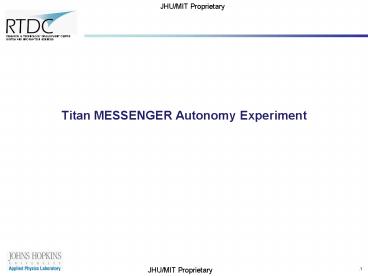Titan MESSENGER Autonomy Experiment - PowerPoint PPT Presentation
Title:
Titan MESSENGER Autonomy Experiment
Description:
Development Can Parallel multi-year Cruise Phase ... Pre Ship. Review. Launch. DFS/ECS. MiniME .5. RESEARCH & TECHNOLOGY DEVELOPMENT CENTER ... – PowerPoint PPT presentation
Number of Views:26
Avg rating:3.0/5.0
Title: Titan MESSENGER Autonomy Experiment
1
Titan MESSENGER Autonomy Experiment
2
Rationale
- ST7 Experience Has Shown That Dedicated Autonomy
Experiments are not Cost Effective. The
Technology Must Be Introduced into an Existing
Mission Framework. - but
- Various Studies Have Concluded that Autonomy
Capabilities and Requirements Must Be Considered
At System Design Time To Achieve Significant
Cost/Capability Impact. - The MESSENGER Mission Provides a Unique
Opportunity to Achieve Cost-Effective Operational
Autonomy by 2010. - Deep Space Environment
- Capable On-board Processing Baseline.
- On-board Fuel Resources for Extended Orbital Ops
(Currently Unplanned) - Development Can Parallel multi-year Cruise Phase
- PI Support for Autonomous Science Platform
Concept
3
Reference Mission
- MErcury Surface, Space ENvironment, GEochemistry
and Ranging (MESSENGER) Mission. - April 2004 Launch
- June 2006 Orbit Insertion
- Four RAD6000 Processors Onboard (25 MHz Clock,
24MB SRAM) - Dedicated Fault Protection Processor Architecture
- Legacy Onboard Autonomy Engine
4
MESSENGER Mission Timelines
Development
2001
2002
2003
2004
PDR
CDR
Start IT
Pre Ship Review
Launch
DFS/ECS MiniME
Potential Autonomous Mercury Ops Phase
Operations
2004
2005
2006
2007
2008
2009
2010
2011
Launch
Venus Flyby 2
Mercury Flyby 1
Mercury Flyby 2
Mercury Orbit Insertion
End Scheduled Mercury Ops
End Extended Mercury Ops
Venus Flyby 1
5
Objectives
- Conclusively Demonstrate Direct NASA Relevance of
Model-based Programming and Execution Frameworks
in Science-driven Mission Scenario. - Verifiable Autonomous Behavior
- Reactive Time Scales
- Establish Essential Connection Between Autonomy
Technology Developers and Mission Systems and
Software Engineering. - Bridge Current Practices into New Technology
Frameworks. - Rule-based Systems into Model-based Systems
6
Architecture Comparison
Baseline
Rule List
Autonomy Rule Engine
Telemetry
Safe-hold Earth Acq
Commands
Command Sequence
Mission Planning (ground)
Command Processing
Commands
Clock
Model-based
Model-based Executive
Activity Selection
Plant Model
Execution Model
Mission Planning
State Estimates
Telemetry
Deductive Controller
Control Sequencer
Clock
Commands
Configuration Goals
Safe-hold Earth Acq
7
Autonomy Rules in Current Application
Example from MESSENGER Safing and Fault
Protection Requirements Specification. (Flight
Software Design to Support 1280 Rules)
8
General Plan
- Initial Science Concept Study and Technology
Development - Development of Ground Operations Decision Support
Tool - Realistic Scale Model Development
- Shadow Mode Performance Assessment
- Operator Interface
- Flight Architecture Build Update Bench Test
- Operator Training
- Spacecraft Reconfiguration and Checkout
- Autonomous Planetary Operations in Extended
Mission Phase
9
Master Schedule
10
Mission Operations Automation Framework
Science Goals
S/C Maintenance Requirements
State Recovery Goals
Maintenance Activity Generation
Science Activity Generation
Activity Merging
Sequence Generation
Planning Scheduling
Sequence Validation Expectation Generation
S/C State Model
Command Uplink
S/C
Epoch 2000
Near Term Focus
Telemetry Downlink
Performance Assessment
Contact Automation
Real-time Mission Ops
Anomaly
State Update
State Recovery
Contingency Operations































